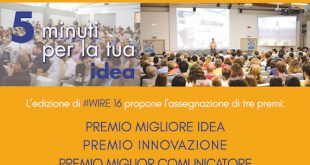You can now apply for the Romeo Bassoli scholarship, named after this science journalist who managed the INFN Communication office from 2007 to 2013. The scholarship, at the INFN Communication office, is addressed to young science communicators, and will concern institutional communication and scientific dissemination. The grant is for six months, possibly extendable to six further months.
Read More »News
Stages estivi e residenziali 2016
The XVII edition of the 2016 Stages Estivi e Residenziali is approaching fast. They’ll be back this year with three different programs addressed to high school students from all over Italy. The 132 students will have a chance to get hands-on training in the different management and research fields at LNF, alongside the actual experts. For more information about our Stages visit our website: http://edu.lnf.infn.it/stages-estivi-residenziali-2016/
Read More »Incontri di Fisica 2016
Registration is now open to the refresher course in Modern Physics for high school teachers and scientific journalists from all over Italy, organized by the National Laboratory of Frascati. This year the course gets a full makeover, starting from a new educational offer. Thise who are interested shall choose among two different paths, based on different level of analysis: – IDF 2.0 (e-learning formula + attendance) – IDF with attendance at the LNF.
Read More »Open labs 2016… follow the wave! at LNF
Saturday 14 may, at 10 pm, the traditional National Laboratory of Frascati open day successfully came to an end. 2500 visitors of every age, whole families and children, students, an interested and curious public. 116 Students in Staff coming from 15 high schools from surroundings of Rome, involved in a stage dedicated to the organization of the event. 150 employees, associated personnel and LNF guests who took care of welcoming our guests and communicating with enthusiasm their research activity in the welcoming and stimulating environment of our Laboratory.
Read More »#WIRE16 5 minuti per la tua idea!
C’è tempo fino al 29 maggio per compilare l’iscrizione sul sito web di Frascati Scienza e proporre la propria idea per WIRE16 – Workshop Impresa, Ricerca ed Economia. Il workshop si propone di riunire imprenditori, ricercatori e finanziatori per discutere di ricerca, innovazioni nel campo del design, tecnologia e informatica, idee per creare infrastrutture, laboratori e opportunità di lavoro per i giovani.
Read More »LHC starts the new data taking: a new adventure begins
Protons have started colliding again in the super-accelerator LHC at CERN in Geneva. A new phase of data taking will allow physicists to continue the exploration of the Universe, of the bricks of the matter and of the fundamental laws. LHC has already shown its big potentialities bringing science to the frontier of knowledge. The measurements foreseen will bring us to a deeper understanding of physics.
Read More »Borse Summer Student 2016 ai LNF
Anche quest’anno i Laboratori Nazionali di Frascati offrono la possibilità, nel periodo estivo, a 5 studenti universitari o neolaureati di svolgere attività di ricerca all’interno di un gruppo sperimentale. Le borse riguardano settore scientifico, tecnico-applicativo e gestionale-amministrativo. I dettagli del programma e le modalità per partecipare alla selezione sono disponibili al seguente indirizzo: http://www.ac.infn.it/personale/borsedistudio/pdf/getfile.php?filename=18041.pdf
Read More »The SETI Project
“Spring School Colloquium” dei Laboratori Nazionali di Frascati – INFN: The SETI Project. Explore, understand and explain the origin, nature and prevalence of life in the Universe Martedì 10 Maggio 2016, ore 18.00 Via E. Fermi 40 – Frascati (RM) Seth Shostak (Senior Astronomer and Director, Center for SETI research)
Read More »OpenLabs 2016 … chase the Wave!
Saturday, May 14th, 2016 INFN – Laboratori Nazionali di Frascati Via Enrico Fermi, 40 – Frascati (RM) FREE ENTRY 10:00 – 21:00
Read More »Quartz bars as particle detectors
“Seeing” a high energy particle requires special detectors exploiting peculiar phenomena of interaction of particles with the matter. The Cherenkov effect is one of such phenomena: when a high energy particle crosses a material (a “radiator”) flashes of blue (or even ultra-violet) light are emitted. Such emission happens whenever the particle crosses the radiator with a speed larger than the light speed in that same material, an analog of the supersonic “boom” of the aircraft when they moves faster that the speed of sound.
Read More » INFN-LNF Laboratori Nazionali di Frascati
INFN-LNF Laboratori Nazionali di Frascati









